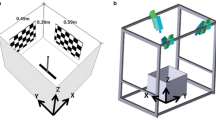Summary
-
1.
Euphausiids (Nematoscelis atlantica) move their eyes through 180° in response to the movement of a small light source. In the sea the effect would be for the upper eye to track the direction of the downwelling light (Figs. 1 and 2). The ventral photophores always rotate in synchrony with the eyes and through the same angle.
-
2.
The tail also follows movements of the light, but only when the eye is in particular positions in its orbit. As the eye moves backwards the tail moves up and vice versa (Figs. 3 and 4). The effect of the tail movements on a freely rotating animal is to cause the body to maintain a constant angle to the light (Figs. 5 and 8).
-
3.
The eye movements have a latency of about 80 ms, and maximum angular velocities of about 200°s−1. Tail movements are synchronous with eye movements, but the effect of the rudder action is slow so that corrective body movements may take several seconds to complete (Figs. 5 and 6).
-
4.
Different animals maintain different body angles with respect to the light. It is assumed that these angles represent different phases of diurnal migration. The one parameter that changes when a new course is adopted is the position of the eye in the orbit about which tail movements are initiated. This can be represented as a variable set-point in the feedback loop that controls the action of the tail (Fig. 9). This system of steering is formally similar to the way a helmsman steers a boat with the aid of a compass (Fig. 8).
-
5.
During tail flips this closed-loop navigation system is over-ridden by a programme in which eye and tail move in the same direction, and with different time courses. This is interpreted as a mechanism for ensuring that the eye continues to point upwards during the rapid phase of the movement that results from the tail flip (Fig. 7), and which the closed-loop mechanism would be too slow to deal with.
Similar content being viewed by others
References
Baker, A. de C.: The vertical distribution of euphausiids near Fuerteventura, Canary Islands (‘Discovery’ SOND Cruise, 1965). J. Mar. Biol. Ass. U.K.50, 301–342 (1970)
Brinton, E.: Euphausiids of Southeast Asian waters. Naga Report, Vol. 4, Part 5. La Jolla: Scripps Institution of Oceanography 1975
Clarke, W.D.: Function of bioluminescence in mesopelagic organisms. Nature198, 1244–1246 (1963)
Chun, C.: Atlantis: Biologische Studien über pelagische Organismen. Zoologica (Stuttgart)7, 1–260 (1896)
Denton, E.J.: On the organization of reflecting surfaces in some marine animals. Phil. Trans. R. Soc. (London) Biol.258, 285–313 (1970)
Fraenkel, G.S., Gunn, D.L.: The orientation of animals. New York: Dover 1961
Hardy, M.G.: Photophore and eye movement in the euphausiidMeganyctiphanes norvegica (G.O. Sars). Nature196, 790–791 (1962)
Herring, P.J.: Bioluminescence of invertebrates other than insects. In: Bioluminescence in action. Herring, P.J. (ed.), pp. 199–240. London: Academic Press 1978
Jerlov, N.G.: Optical oceanography. Amsterdam: Elsevier 1968
Kils, U.: Schwimmverhalten, Schwimmleistung und Energiebilanz des Antarktischen Krills,Euphausia superba. Ber. Inst. Meereskunde, Christian-Albrechts Univ. Kiel, Nr. 65 (1979)
Land, M.F., Burton, F.A., Meyer-Rochow, V.B.: The optical geometry of euphausiid eyes, J. Comp. Physiol.130, 49–62 (1979)
Lythgoe, J.N.: Ecology of vision. Oxford: Clarendon Press 1979
Mauchline, J., Fisher, L.R.: The biology of euphausiids. Adv. Mar. Biol.7, 1–454 (1969)
Melvill Jones, G.: Organization of neural control in the vestibuloocular reflex arc. In: The control of eye movements. Bach-y-Rita, P., Collins, C.C., Hyde, J.E, (eds.), pp. 497–518. New York: Academic Press 1971
Mittelstaedt, H.: Prey capture in mantids. In: Recent advances in invertebrate physiology. Scheer, B.T. (ed.), pp. 51–71. Eugene: Univ. of Oregon Press 1957
Omori, M.: The biology of pelagic shrimps in the ocean. Adv. Mar. Biol.12, 233–324 (1974)
Robinson, D.A.: Eye movement control in primates. Science161, 1219–1224 (1968)
Warner, J.A., Latz, M.I., Case, J.F.: Cryptic bioluminescence in a midwater shrimp. Science203, 1109–1110 (1979)
Author information
Authors and Affiliations
Additional information
I am grateful to Peter Herring and the staff of the Institute of Oceanographic Sciences, Wormley, U.K., for making possible my participation on the “Discovery” cruise. Peter Herring, Arthur Baker and Jean-Marie Bassot all gave me helpful advice, and I am particularly grateful to J.-M. Bassot for loaning me his video equipment, which was indispensible. Philip James and Lyn Rigby helped to identify specimens. Thomas Collett read and criticised the final manuscript, which was typed by Sally Byatt. I am grateful to the N.E.R.C. for support during the cruise, and to the S.R.C. for overall support for the project.
Rights and permissions
About this article
Cite this article
Land, M.F. Eye movements and the mechanism of vertical steering in Euphausiid Crustacea. J. Comp. Physiol. 137, 255–265 (1980). https://doi.org/10.1007/BF00657121
Accepted:
Issue Date:
DOI: https://doi.org/10.1007/BF00657121




